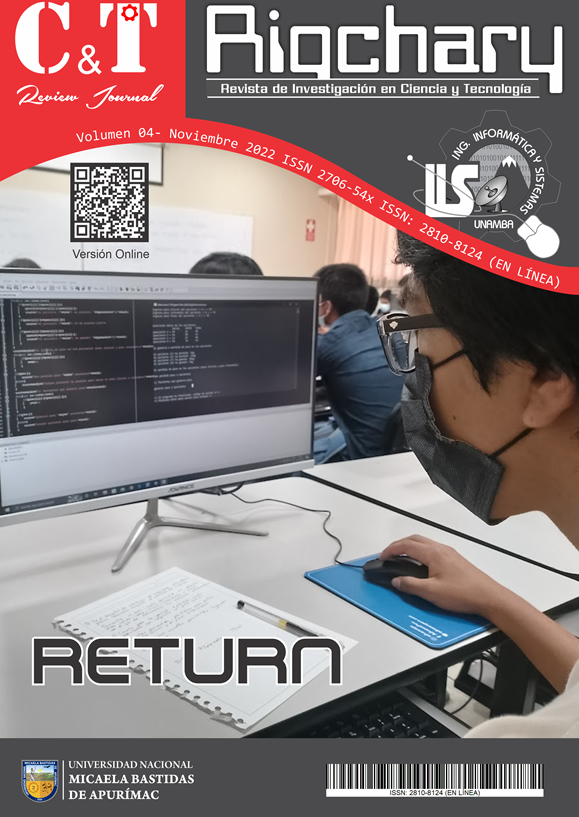Agricultural contaminants in the production of Corn Zea mays L. choclero variety in Curahuasi Apurímac, Peru
Main Article Content
Abstract
The objective of the research was to describe the use of pollutants in the cultivation of Maize Zea mays L. The study was carried out in the district of Curahuasi, Abancay Apurímac Province, Peru. The type of study was quantitative with an explanatory level. The Concacha-Curahuasi transect was evaluated, simple random probabilistic sampling was applied in a total population of 345 families from the communities and producer associations, the sample was 20% of farmers. The field work was carried out in October 2018. The results achieved showed that 92.16% of farmers use insecticides indiscriminately to control the aforementioned pests, 94.1% consider that corn, water and soil are contaminated. They do not do any treatment for the final disposal of empty containers. In conclusion, in the production of choclero corn, in Curahuasi, they use agrochemicals that contaminate the crops and the environment.
Article Details

This work is licensed under a Creative Commons Attribution-NonCommercial-NoDerivatives 4.0 International License.
When an author creates an article and publishes it in a journal, the copyright passes to the journal as part of the publishing agreement. Therefore, the journal becomes the owner of the rights to reproduce, distribute and sell the article. The author retains some rights, such as the right to be recognized as the creator of the article and the right to use the article for his or her own scholarly or research purposes, unless otherwise agreed in the publication agreement.
How to Cite
References
Saavedra, G. 2014. El Cultivo de Maíz Choclero y Dulce. Santiago, Chile. Instituto de Investigacio-nes Agropecuarias. Boletín Nº 303. 146p. ISSN 0717 – 4829. Disponible en: http://biblioteca.inia.cl/medios/biblioteca/ bole-tines/NR40102.pdf.
Guerrero P. (2018) Manejo de plaguicidas en cultivos de Zea mays L. “maíz” (Poaceae), Brassica cretica Lam. “brócoli” (Brassicaceae), Apium graveolens L. “apio”, Coriandrum sativum L.“cilantro” (Apiaceae), Allium fistulosum L. “ce-bolla china” (Amaryllidaceae) en la campiña de Moche, Trujillo, Perú Arnaldoa 25 (1): 159 - 178, 2018. Disponible en: http://doi.org/10.22497/arnaldoa.251.25110
Benítez-Leite S1 , Macchi1 ML, Acosta M. 2007. Malformaciones congénitas asociadas a agrotóxicos. Artículo original Pediatr. (Asunción), Vol. 34; Nº 2; 2007. Disponible en: http://scielo.iics.una.py/pdf/ped/v34n2/v34 n2a02.pdf
Yucra Sandra, Gasco M., Rubio G., Gonzales F.,2008. Exposición ocupacional a plomo y pesticidas órganofosforados: efecto sobre la salud re-productiva masculina. Rev Perú Med Exp Salud Publica. 2008; 25(4): 394 394-402. Artículo en revisión. Disponible en: http://www.scielo.org.pe/pdf/rins/v25n4/a09v25n4
Hernández H. B., Torres A. H., Sánchez C., G, Reyes V. L., Zapién M. A. 2019. Uso de plaguicidas en el cultivo de maíz en zonas rurales del Es-tado de Oaxaca, México. Rev. salud ambient. 2019; 19(1):23-31. Disponible en: fi-le:///C:/Users/USUARIO/Downloads/92 6-4663-1-PB.pdf
Flores S. L., Pirro L. M. M., Vargas E. L. Marín G. M., Bollet R.F. 2018. Efecto residual de insectici-das en granos de maíz amarillo (Zea mayz l.) en diferentes estados de madurez procedente de cul-tivos de suelos de restinga, Ucayali 2014. articulo original. Disponible en. fi-le:///C:/Users/USUARIO/Downloads/79Texto%20del%20art%C3%ADculo-3451-10-20180820.pdf
Del Puerto R., A. M.; Suárez T., S.; Palacio E., D. 2014. Efectos de los plaguicidas sobre el ambiente y la salud Revista Cubana de Higiene y Epidemio-logía, vol. 52, núm. 3, septiembre-diciembre, 2014, pp. 372-387 Instituto Nacional de Higiene, Epidemiología y Microbiología Ciudad de La Haba-na. Disponible en: https://www.redalyc.org/pdf/2232/223240764010.pdf
Ministerio de Agricultura y Riego Encuesta Nacional de Intenciones de Siembras 2018. Disponible en: http://siea.minagri.gob.pe/siea/sites/defa ult/files/resumen-ejecutivo-enis2018rev18jul18.pdf
Ministerio de Agricultura Plan Nacional de Culti-vos 2018-2019. Disponible en: https://www.agromoquegua.gob.pe/doc/PLAN_NACIONAL_DE_CULTIVOS_2018-2019.pdf
Mostafalow S. Abdollahi M. (2013) Pesticides and human chronic diseases: evidences, mechanisms, and perspectives. Department of Toxicology and Pharmacology, Faculty of Pharmacy and Pharmaceutical Sciences Research Center, Tehran Univer-sity of Medical Sciences, Tehran, Iran. PMID: 23402800. DOI: 10.1016/j.taap.2013.01.025, [In-dexed for MEDLINE] https://www.ncbi.nlm.nih.gov/pubmed/23402800 and perspectives. Department of Toxicology and Pharmacology, Faculty of Pharmacy and Pharmaceutical Sciences Research Center, Tehran University of Medical Sciences, Tehran, Iran. PMID: 23402800. DOI: 10.1016/j.taap.2013.01.025,https://www.ncbi.nlm.nih.gov/pubmed/23402800
Rojas, D.; Messina, V., M.; Sancho, A. M.; Pesque-ra, N.; Cristos, D. S.; 2014. Cuantificación de plaguicidas residuales en granos de maíz (Zea mays L.) aplicando técnicas de evaluación residual; Asociación Revista Venezolana de Ciencia y Tecnología de Alimentos; Revista Venezolana de Ciencia y Tecnología de los Alimentos; 5; 1;1-2014;1-17. URI: http://hdl.handle.net/11336/30119. Dispo-nible en: https://ri.conicet.gov.ar/handle/11336/30119





